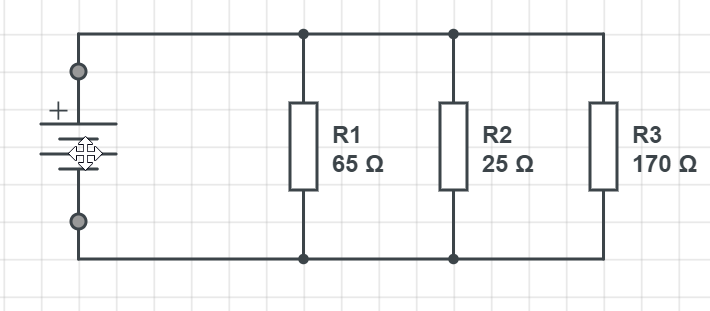
All Solutions
Page 762: Practice Problems
Since the resistors are connected in parallel, the equal (total) resistance can be calculated as:
$$
frac{1}{R_{mathrm{eq}}}=frac{1}{R_{1}}+frac{1}{R_{2}}+frac{1}{R_{3}}
$$
Putting in the numbers we have:
$$
frac{1}{R_{mathrm{eq}}}=frac{1}{250 Omega}+frac{1}{150 Omega}+frac{1}{525 Omega}
$$
which gives the total resistance of:
$$
R_{mathrm{eq}}=frac{1}{0.01257 Omega^{-1}}=79.55 Omega
$$
now using Ohm’s law, we calculate the total current:
$$
I = frac{U}{R} = frac{24.0 mathrm{~V}}{79.55 Omega}
$$
which gives the result of:
$$
boxed{color{#c34632}I = 0.301 mathrm{A}}
$$
We can conclude from the numerical calculation that the current decreases, but even more from the formula for the total resistance in the parallel-connected resistors, we can see that raising the resistance by one resistor, will raise the total resistance in the circuit, which is going $textbf{lower}$ the current given by battery if we are looking the relation with the help of Ohm’s law.
(a) Rightarrow mathrm{decreases}
$$
$$
(b) I= 0.301 mathrm{A}
$$
$$
frac{1}{R_{e q}}=left(frac{1}{R_{1}}+frac{1}{R_{2}}+frac{1}{R_{3}}+ldots +frac{1}{R_{n}} right )
$$
We can call a minimum number of needed resistor for our problem n, so for equal resistance we have then:
$$
frac{1}{R_{e q}}=left(frac{n}{R}right)
$$
which gives for n:
$$
n=frac{R}{R_{e q}}
$$
Putting in the numbers we have:
$$
n=frac{65 Omega}{11 Omega}
$$
which gives the result of:
$$
n=5.9
$$
We can not possibly have 5.9 resistors, so this means we will need at least 6 resistors of 65 $mathrm{Omega}$ resistance to have wished eqaul resistance.

$$
I=frac{varepsilon}{R_{mathrm{eq}}}
$$
and we can see that knowing the current, first, we can calculate the equal resistance. Since we have a parallel connection use the following:
$$
frac{1}{R_{mathrm{eq}}}=frac{1}{R_{1}}+frac{1}{R_{2}}+frac{1}{R_{3}}
$$
putting in the numbers we have:
$$
frac{1}{R_{mathrm{eq}}}=frac{1}{65 Omega}+frac{1}{25 Omega}+frac{1}{170 Omega}
$$
which gives:
$$
R_{mathrm{eq}}=frac{1}{0.061267 Omega^{-1}}=16.32 Omega
$$
Now we calculate the emf with Ohm’s law:
$$
varepsilon=IR = 1.8 mathrm{A} cdot 16.32 Omega
$$
And we have the result of:
$$
boxed{color{#c34632}varepsilon= 29.37 mathrm{V}}
$$
varepsilon= 29.37 mathrm{V}
$$
Haven't found what you were looking for?
Search for samples, answers to your questions and flashcards

